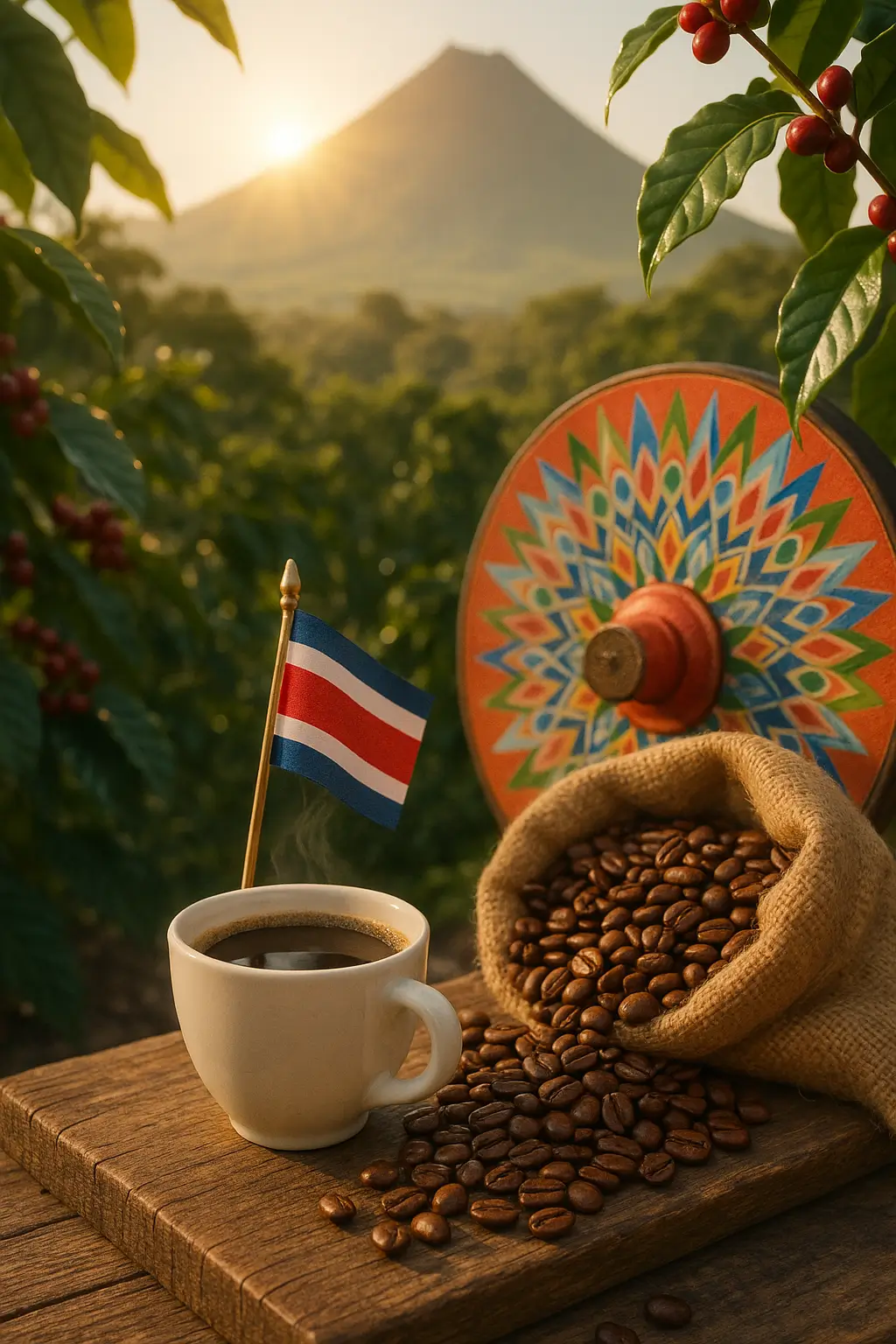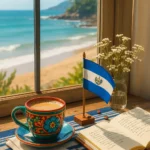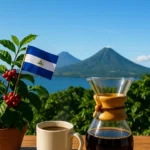Costa Rican coffee is famous worldwide. It has a bright, clean taste and a balanced flavor. Locals call it “grano de oro,” or golden grain. It stands apart from other Central and South American coffees. This coffee is a national symbol and a key part of Costa Rica’s economy. You’ll learn about its unique taste, the regions where it grows, how it’s processed, the main types of beans, and its impact on the country.
- What does Costa Rican coffee taste like?
- Where does Costa Rican coffee grow?
- What processing methods are used for Costa Rican coffee?
- What common coffee varietals are cultivated in Costa Rica?
- What is the economic and cultural significance of Costa Rican coffee?
- What regulations and quality standards ensure excellence in Costa Rican coffee?
- What makes Costa Rican coffee special?
- Costa Rican Coffee: Quick Overview
What does Costa Rican coffee taste like?
Costa Rican coffee has a bright acidity, a clean taste, and a complex, balanced flavor. It usually has a medium to full body. The lively acidity feels crisp on your tongue. When you taste it, look for these common notes:
- Vibrant citrus, like orange and lemon,
- Sweet undertones of honey and rich caramel,
- Hints of chocolate,
- Delicate floral notes, such as jasmine or rose,
- Fruity nuances, including cherry, apple, and tropical fruits,
- Pleasing sweetness,
- Subtle nutty or earthy undertones, depending on the region.
Farmers grow this coffee high in the mountains, typically between 1200 and 1800 meters. This high altitude helps create its crisp acidity, clean taste, and complex flavor.
Where does Costa Rican coffee grow?
Costa Rica’s main coffee regions each add something special to the coffee. These areas include Tarrazú, Tres Ríos, Central Valley, West Valley, Brunca (Perez Zeledón), Orosi Valley, Turrialba, and the East Region. Each region has specific factors—high altitudes, fertile volcanic soils, and a consistent tropical climate with wet and dry seasons—that affect the coffee’s quality and taste.
What makes Tarrazú a top Costa Rican coffee region?
Tarrazú is Costa Rica’s largest and most important coffee region. It produces highly sought-after coffee beans. Its high elevations, from 1,200 to 1,900 meters, mean the coffee ripens slowly. This longer ripening time helps coffee cherries develop dense beans with complex flavors. Tarrazu coffee usually has a full body, low acidity, and a smooth flavor. You’ll often find nutty or earthy undertones, sometimes with a hint of chocolate.
What defines Central Valley and West Valley Costa Rican coffee?
Central Valley and West Valley coffees thrive in rich volcanic soil, mild temperatures, and clear wet and dry seasons. These conditions are perfect for growing high-quality coffee. Central Valley coffees typically have bright acidity and a medium body. Their flavor often includes strong fruity notes, like berries, and delicate floral notes. This makes a lively, aromatic cup.
What is characteristic of Tres Ríos Costa Rican coffee?
Tres Ríos is another highly respected coffee region. It has rich volcanic soil and ideal weather conditions. These factors provide the right balance of moisture and temperature for coffee to grow well. The region’s careful farming practices help it produce excellent coffee.
What are the flavor notes of Brunca (Perez Zeledón) Costa Rican coffee?
Brunca, also known as Perez Zeledón, sits on a high plateau around 1,400 meters. It has cloud forests and many different plants and animals. The region is cool with steady rain, which is great for certain coffee types. Farmers in Brunca mostly grow Caturra and Catuai varieties. These produce a balanced cup, often with berry and sweet caramel notes.
What distinguishes Orosi Valley Costa Rican coffee?
The Orosi Valley coffee region is about 1,400 meters high, on fertile volcanic foothills. Its unique organic topsoil helps create the coffee’s distinct flavor. Orosi Valley coffee often tastes acidic. It can have nutty undertones and sometimes wine-like notes. The region is known for its organic farming and for producing high-quality small-batch coffee.
What defines Turrialba and East Region Costa Rican coffee?
Turrialba, in eastern Costa Rica, has lower elevations and a warmer, more humid climate. These conditions lead to earlier harvests and faster ripening times for coffee cherries. While sometimes less complex than coffees from higher regions, Turrialba coffee benefits from the rich volcanic soil near the Turrialba volcano. This soil gives the coffee unique qualities. The broader East Region shares these tropical climate features, adding to Costa Rica’s variety of coffee regions.
What processing methods are used for Costa Rican coffee?
Costa Rican coffee beans are mostly processed using the washed method. The honey process is also common, and the natural (dry) process is used less often. Each method changes the final flavor of the coffee bean.
How does the washed process affect Costa Rican coffee?
The washed process, also called the wet process, is the standard method for Costa Rican coffee. It gives the coffee clarity and brightness. First, workers remove all the skin and most of the pulp from the coffee cherry. Then, machines press and squeeze the beans, and centrifuges remove any remaining sticky mucilage. After thorough washing, the green coffee beans dry for two to three weeks, often in special greenhouses. This careful process brings out the coffee’s natural acidity, resulting in a clean taste, a brighter cup, and a lighter body. Some local variations include using less water for washing or different wet and dry fermentation techniques.
What flavor does the honey process impart to Costa Rican coffee?
The honey process is a middle-ground method for Costa Rican coffee. Some mucilage stays on the bean while it dries. This sticky layer gives the process its name, not actual honey. The coffee gets a unique flavor profile that combines traits from both washed and natural methods. Honey-processed coffee often tastes sweeter and has a fuller body than fully washed coffees.
How does the natural (dry) process influence Costa Rican coffee?
The natural, or dry, process is a traditional way to prepare Costa Rican coffee. It creates a fuller body and strong fruity flavors. In this method, whole coffee cherries dry directly after harvest. Workers spread them on large patios or raised beds under the sun. This drying can take up to six weeks. The coffee bean absorbs flavors from the fruit around it. While not as common as the washed method in Costa Rica, farmers use it more for high-quality natural microlots, which offer a distinct and intense flavor.
What common coffee varietals are cultivated in Costa Rica?
Costa Rican law states that only Arabica coffee can be grown. The main types are Caturra and Catuai. These two varieties are the foundation of the country’s coffee production, valued for their quality.
What are Caturra and Catuai, the pillars of Costa Rican coffee production?
Caturra is a traditional staple for Costa Rican coffee. Farmers grow it widely, and it produces a bright, full-bodied cup. This Arabica variety has long been essential to the nation’s coffee industry. Catuai is another common variety that growers cultivate across the country. Both Caturra and Catuai provide the consistent quality and flavor you expect from premium Costa Rican coffee.
What other important varietals and hybrids are grown for Costa Rican coffee?
Besides Caturra and Catuai, Costa Rican coffee farmers also grow other important Arabica varieties. These include Typica and Bourbon, though they are less common. Some specialty micro-lots may feature the rare Gesha variety. People seek it for its complex, aromatic qualities. Other varieties like Mundo Novo and Villa Sarchi also add to the country’s diverse coffee landscape. Farmers also increasingly use disease-resistant hybrids like Sarchimor and Obata—a Caturra x Timor hybrid. These hybrids resist coffee leaf rust better and produce higher yields, helping ensure the future of Costa Rican Arabica coffee.
What is the economic and cultural significance of Costa Rican coffee?
Costa Rican coffee has deeply shaped the nation’s economy and its identity. Since the early 19th century, it has driven economic growth and become a strong cultural symbol. It helped Costa Rica change from a farming society into a more modern, thriving nation.
What is the economic impact of Costa Rican coffee, from “Golden Grain” to modern challenges?
Historically, Costa Rican coffee was the country’s main export and a major source of tax revenue. It powered significant economic growth and modernization. This success led to important infrastructure projects, including railways and ports built just for the coffee trade. The money from coffee farming also helped create a large middle class in Costa Rica, contributing to its stability compared to other Central American countries.
However, the coffee sector faces tough times now. Production has dropped sharply since the 1990s. The number of coffee farmers has nearly halved in the last ten years. These challenges come from several issues:
- Low coffee prices,
- An aging farmer population,
- Ongoing labor shortages,
- High land prices,
- Increased global competition.
Even with recent increases in production, the industry struggles with labor issues and economic changes, like currency instability. This threatens its long-term ability to compete as Costa Rica shifts toward other profitable industries. In response, Costa Rican coffee producers are adapting. They focus on specialty coffee and microlots to get higher prices. The number of micro-mills, which support small groups of farms, has doubled in the last decade. These efforts aim to protect Costa Rican coffee’s future by balancing its cultural roots with economic flexibility.
How does Costa Rican coffee represent a cultural heartbeat in Tico life?
Costa Rican coffee connects deeply with the nation’s culture. People know it as “grano de oro”—golden grain—symbolizing its heritage and importance. This coffee greatly influences social life, shaping daily routines and community gatherings. Coffee farming remains a vital income source, supporting thousands of rural families, especially in the fertile highlands. Famous places, like the National Theatre in San José, show the prosperity coffee brought to the nation. Coffee taxes even helped fund it. This widespread influence means Costa Rica’s coffee culture remains a vibrant part of its national character.
What regulations and quality standards ensure excellence in Costa Rican coffee?
Costa Rican coffee production and export follow strict rules and quality standards. This shows a strong commitment to excellence, environmental care, and pure coffee varieties. These measures help keep Costa Rican coffee’s global reputation strong.
What is the Arabica-only mandate for Costa Rican coffee?
A key rule for Costa Rican coffee is a 1989 law. It legally requires farmers to grow only Arabica coffee. It strictly bans Robusta varieties. This policy ensures high quality by focusing on the more flavorful Arabica species. This dedication to Arabica coffee is a main reason for Costa Rica’s premium reputation.
What national export standards apply to Costa Rican coffee?
National export standards carefully control the quality of Costa Rican coffee before it leaves the country. These standards, set by decrees like Joint Executive Decree No 27/92, create exact rules for green coffee beans. Quality criteria include:
- Bean size,
- Moisture content,
- Acceptable defects,
- Odor,
- Color,
- Cup taste evaluations.
These strict requirements ensure that only top-quality Costa Rican coffee gets exported, keeping consistency and consumer trust high.
How does environmental sustainability and EU Green Deal compliance affect Costa Rican coffee?
Costa Rican coffee production actively works with international environmental rules, especially anticipating the European Union Green Deal. A critical rule starting in 2025 says all exported coffee must be deforestation-free. Exporters must provide detailed documents that trace coffee origins and confirm sustainable farming practices. This commitment shows Costa Rica’s dedication to protecting the environment and its leadership in sustainable farming. It also further strengthens the value of the specialty coffee Costa Rica produces.
What role do certification marks play for Costa Rican coffee?
Certification marks are vital for confirming the quality and origin of Costa Rican coffee. The Tarrazú certification, for example, proves that coffee comes from this famous region. It also shows it meets strict quality standards set by governing bodies. These certifications boost the country’s reputation for producing top-tier coffee from specific, known areas. They assure you about the authenticity and quality of your Costa Rican coffee.
What makes Costa Rican coffee special?
Costa Rican coffee stands out because of its amazing flavor, diverse regional traits, careful processing, and deep commitment to quality and sustainability. Its bright acidity, clean taste, and complex notes come from growing at high altitudes in volcanic soil. This defines its unique appeal. Even with current challenges—like fewer farmers and less production—the “grano de oro” remains a strong symbol of Costa Rica’s economic journey and rich culture.
The nation only grows Arabica coffee, a rule that combines with strict quality checks and a focus on environmental sustainability. This ensures a consistently premium product. From the famous Tarrazu coffee to the new microlots, every cup holds a legacy of excellence. Try our selection of premium Costa Rican coffees today and enjoy a piece of this remarkable heritage.
Costa Rican Coffee: Quick Overview
| Aspect | Key Characteristics | Common Regions | Processing Methods |
|---|---|---|---|
| Flavor Profile | Bright acidity, clean, well-balanced, medium to full body. Notes of citrus, honey, caramel, chocolate, floral, and various fruits. | All regions, with variations based on terroir. | Washed, Honey, Natural |
| Growing Regions | High altitudes, fertile volcanic soils, consistent tropical climate. | Tarrazú, Tres Ríos, Central Valley, West Valley, Brunca, Orosi Valley, Turrialba, East Region. | — |
| Processing Methods | Impact flavor, sweetness, and body. | — | Washed (standard for clarity and brightness), Honey (sweeter, fuller body), Natural (fuller body, prominent fruit). |
| Coffee Varietals | Exclusively Arabica by law. | All regions. | Caturra, Catuai (dominant); Typica, Bourbon, Gesha, Mundo Novo, Villa Sarchi (less common/specialty); Sarchimor, Obata (hybrids for disease resistance). |
| Economic & Cultural Impact | Historical economic driver, national symbol (“grano de oro”). Built infrastructure and middle class. Faces challenges like low prices and labor shortages. Innovating with specialty coffee. Deeply ingrained in daily life and community. | — | — |
| Regulations & Quality | Strict adherence to quality, sustainability. | — | Arabica-only mandate (since 1989). National export standards (bean size, moisture, defects, taste). EU Green Deal compliance (deforestation-free by 2025). Certification marks (e.g., Tarrazú). |









